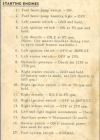- Joined
- May 18, 2007
- Messages
- 6,792
- Display Name
Display name:
jsstevens
I recently flew a Beech 18 while getting my AMES rating. It’s equipped with P&W R-985 engines.
In this plane, the starting sequence was:
1) engage boost pump
2) verify fuel pressure
3) pump off
4) engage starter (after verifying prop clear)
5) count three blades to ensure no hydraulic lock
6) mags on
7) pump throttle around 11 times, fast enough but not too fast (primers not working correctly I was told)
8) at some magic point throttle to idle and engine catches.
My question to you round engine types is: What are you seeing, hearing or sensing that tells you it’s ready to start and you can stop pumping the throttle?
I didn’t observe anything that I could put my finger on. It didn’t puff, cough, stumble or anything I noticed. I told my wife after successfully completing my Checkride that while I can fly it I’m not at all confident I could start it unaided.
John
In this plane, the starting sequence was:
1) engage boost pump
2) verify fuel pressure
3) pump off
4) engage starter (after verifying prop clear)
5) count three blades to ensure no hydraulic lock
6) mags on
7) pump throttle around 11 times, fast enough but not too fast (primers not working correctly I was told)
8) at some magic point throttle to idle and engine catches.
My question to you round engine types is: What are you seeing, hearing or sensing that tells you it’s ready to start and you can stop pumping the throttle?
I didn’t observe anything that I could put my finger on. It didn’t puff, cough, stumble or anything I noticed. I told my wife after successfully completing my Checkride that while I can fly it I’m not at all confident I could start it unaided.
John




